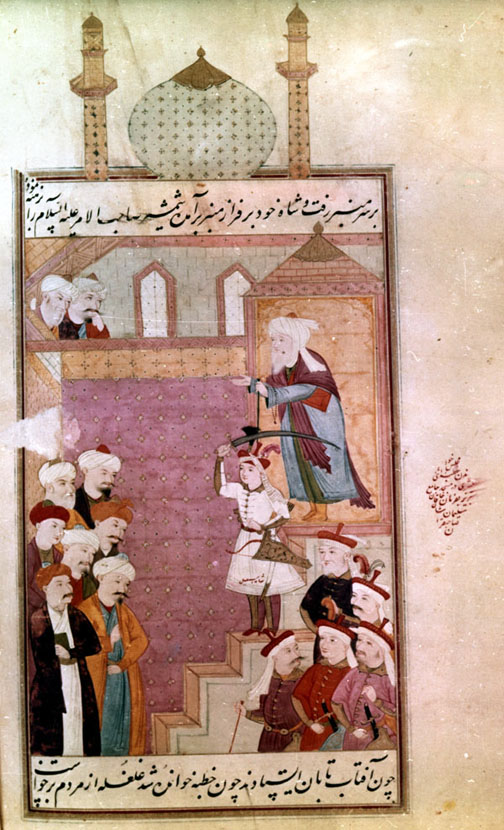Manuscripts
tāriḵ-e ʿālām-ārā-ye šāh esmāʿil
Cf. Ms. L, folio 74, for another version of this subject, and a summary of the event depicted. The date is 907/1501. The place is the Masjed-e Jomʿa in Tabriz, and the event is the simultaneous coronation of Shah Esmāʿil and the adoption of Eṣnā ʿAšari Shiʿism as the official state religion. The painting is almost identical to the rendition in the British Library cited above and varies only in details. It is tighter in draftsmanship and less sketchy in execution than its British Library counterpart. There are also fewer figures represented in the two main groups - seven religious dignitaries and five qezelbāš - as compared to eight and six respectively in the British Library version. And two additional religious figures, or at least their heads, have been added in the upper left peering from a balcony.
A central dome in pale blue tile flanked by two buff minarets, representing the superstructure of the mosque, protrude beyond the frame into the upper margin. On the right, just below the upper text is a pointed mimbar, in light orange and mauve, the steps of which lead diagonally down towards the left. Two steps below the top stands young Esmāʿil, in a white coat with gold trim and red qezelbāš tāj, quiver case and bow on his belt. He raises a sword over his head in ceremonial gesture that denotes both the institution of Shiʿism as the state religion and the commencement of Safavid rule over Iran. At the top is a white-bearded katib, in blue and purple robes and a white turban, his arms outstretched over Esmāʿil’s head. At the base of the steps, on the left, are seven turbanned religious dignitaries organized in pyramidal form; balancing them, on the right, is a group of five qezelbāš organized in similar fashion. The backdrop, the inner walls of the mosque, is executed in light washes of orange, mauve, gray, and white, with the figures standing out in darker tones of blue, purple, red, and orange.

Painting: 27.0 x 13.0 cm. One line of text above and below the painting. Frame encloses painting and text except for the dome and two minarets that protrude into the upper margin. Some minor damage: upper text and marginal inscription smeared; water stain and/or repair just above the religious dignitaries. No sign of retouching. A marginal inscription in red, presumably of later date, describes the event. Another inscription identifies Esmāʿil.
Painting references:
Mahboubian_1972, #923 folio 48v, where it is listed as the “Coronation of Shah Ismael” (not illustrated).
Text X-references:
See Muntaẓer-Ṣāḥeb_1970, p.60 for this event in the History of Shah Esmāʿil.
See Savory, SA_1979, pp.44-45 for this event in the History of Shah ʿĀbbās.
Robert Eng
Last Updated: December 1, 2010
Originally published: March 28, 2002